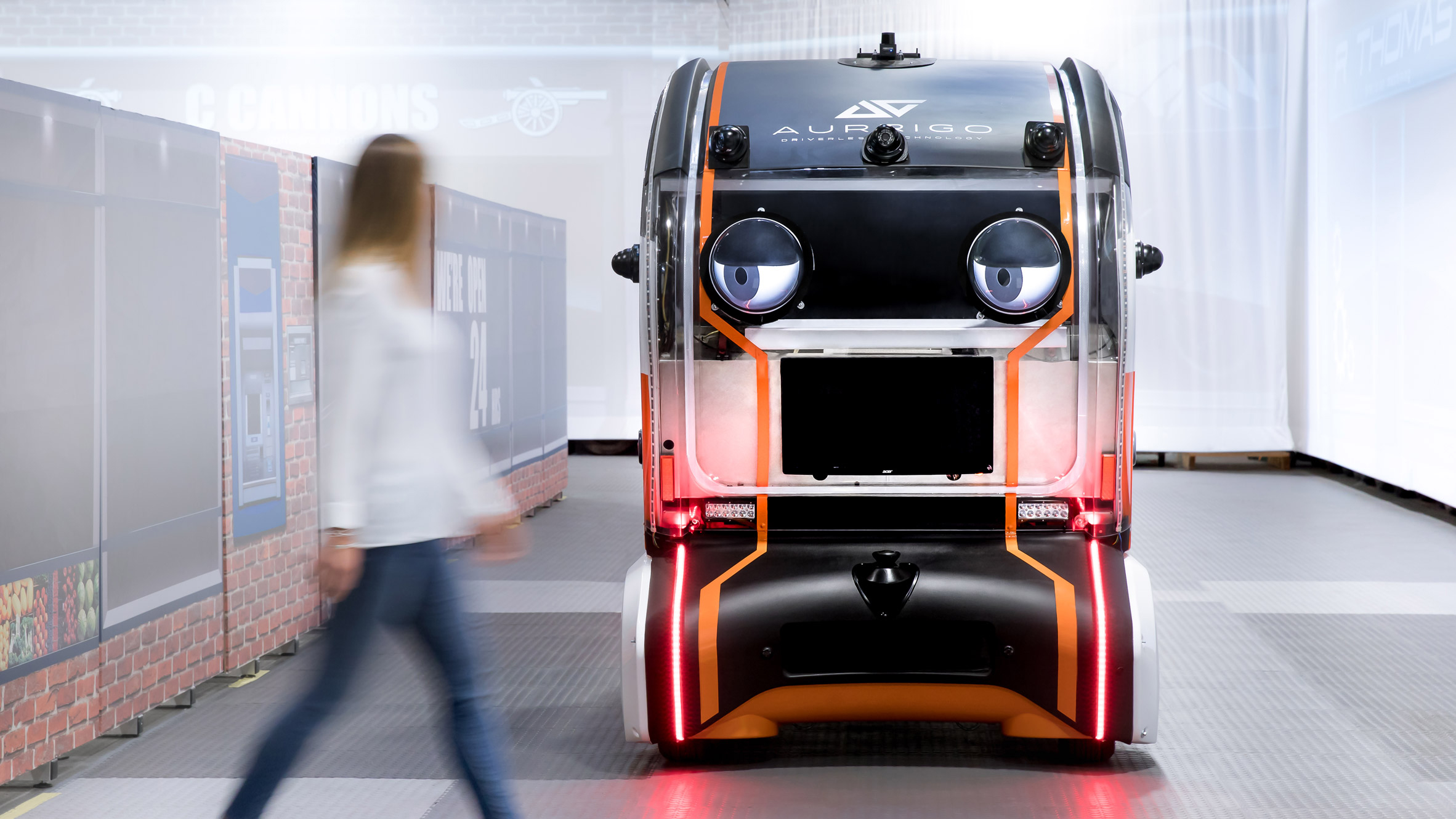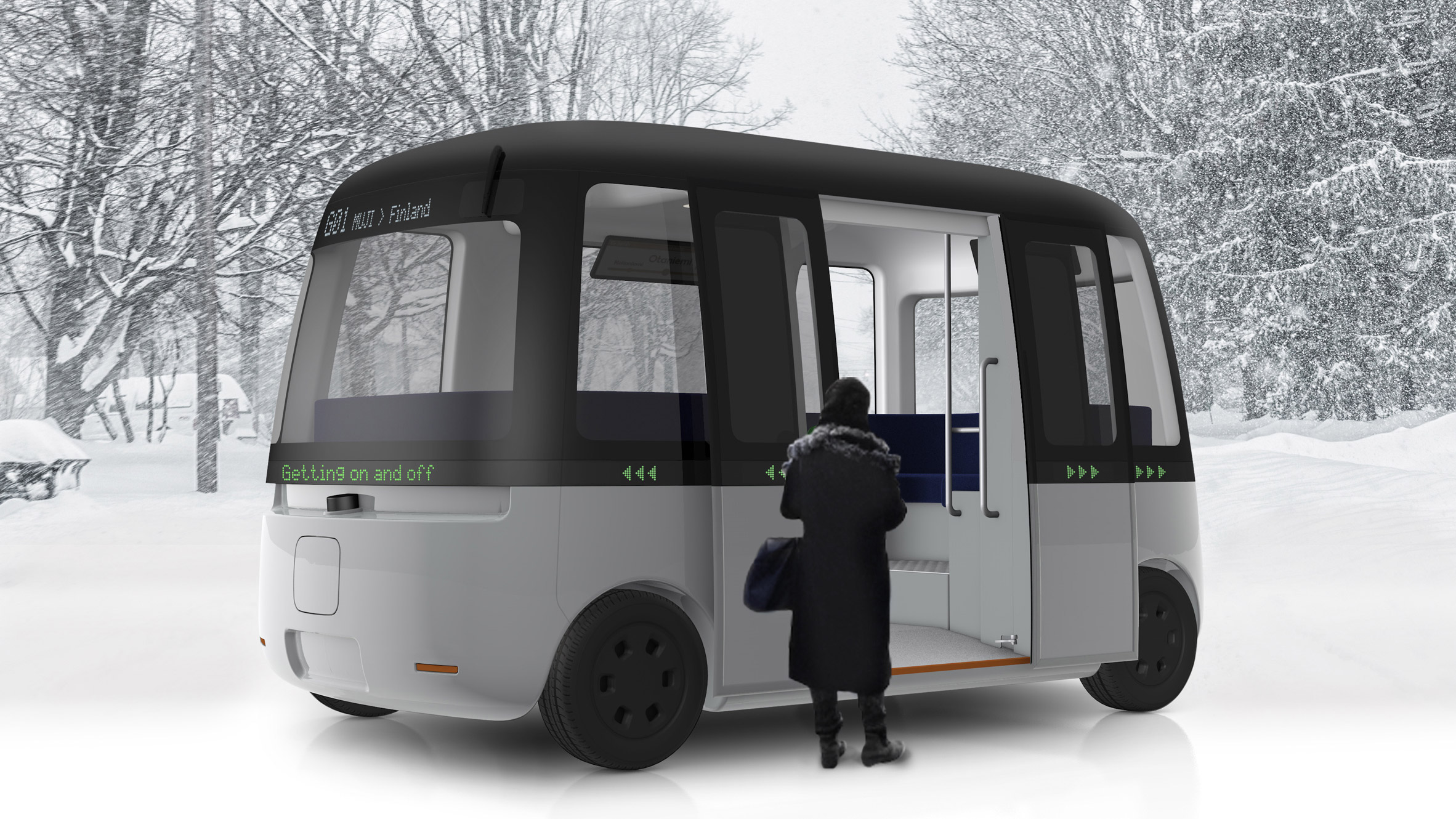For our review of 2018, design reporter Natashah Hitti selects 10 of the forward-thinking transport designs of 2018, including a driverless car with eyes, an airborne taxi and a hotel on wheels.
Dutch aircraft manufacturer Pal-V turned heads this year with its launch of the "world's first" commercial flying car, which can convert from drive to flight mode in under 10 minutes.
Described as a "car that flies" and a "plane that drives", the model is certified to fly under the US Federal Aviation Administration and the European Aviation Safety Agency, and also meets standard road-safety requirements.
Find out more about the Pal-V Liberty ›
Virtual Eye Pod by Jaguar Land Rover
In a bid to make autonomous cars less alienating and more trustworthy for humans, Jaguar Land Rover created a host of driverless vehicles that make eye contact with pedestrians.
With two large round eyes fixed to their fronts, the cars – or "eye pods" – can make eye contact with passers-by, much like human drivers, to acknowledge that they've seen them and are stopping to let them cross the road safely.
Find out more about Jaguar Land Rover's Virtual Eye Pods ›
Uber Air Taxi by Bell Helicopter
Uber also took to the skies this year as it revealed the cabin design for an electric, self-piloting air taxi, intended to be used for its scheduled 2020 aircraft taxi service in partnership with NASA.
Developed by aircraft manufacturer Bell Helicopter, the electric flying taxi is a cross between a traditional helicopter, a light aircraft and a passenger-carrying drone.
Find out more about Uber's electric flying taxi ›
Gacha driverless shuttle bus by Muji
This year also saw Japanese brand Muji use its well-known minimal style to design a "friendly" autonomous shuttle bus built for all weather conditions, which is set to hit the roads in three Finnish cities by 2020.
While Finnish autonomous driving company Sensible 4 developed the algorithms, artificial intelligence and sensory obstacle detection needed to refine the self-driving technology, Muji provided the design aesthetic that earned it its minimal style reputation.
Find out more about Muji's self-driving bus ›
Hyperloop capsule by Priestmangoode
One of the biggest players in the field of transport this year has been hyperloop, the brainchild of Elon Musk. While many concept designs have been released for the near-supersonic transportation system, from well-known firms like UNStudio and Foster + Partners, the very first full-scale passenger hyperloop capsule prototype was unveiled in October, designed by Priestmangoode for Hyperloop Transportation Technologies.
Built using the newly developed material vibranium, the capsule will reportedly be fully optimised and ready for passengers as soon as 2019.
Find out more about Priestmangoode's Hyperloop capsule ›
Renault also jumped on the shared transportation bandwagon with a design for an autonomous and electric vehicle that would provide city dwellers with an alternative to public transport.
Called Ez-Go, the concept functions as both a car and an Uber-style ride-sharing service, designed for riding alone, with friends or family, or shared with other ride-hailing users – who would request the vehicle via a smartphone app.
Find out more about Renault's Ez-Go concept ›
IKEA's innovation lab Space10 envisioned the future of self-driving cars as a series of mobile amenities, including an office, a cafe, a healthcare clinic, a farm, an entertainment unit, a hotel and a pop-up shop.
The project, called Spaces on Wheels, aims to explore how self-driving cars could impact our everyday life once they become ubiquitous – the vehicles would support everyday activities while still transporting users from one place to another.
Find out more about Space10's Spaces on Wheels ›
Swedish car manufacturer Volvo also aimed to make interior spaces mobile this year, with an all-electric autonomous car concept that can double up as a mobile office, bedroom or living room.
Find out more about Volvo's 360c concept ›
Renault developed its Ez-Go concept even further this year by designing a convoy of driverless pods called Ez-Pro that can be used to deliver goods and parcels, or that can transform into mobile pop-up shops.
Autonomous and electric, each delivery service is made up of a self-driving "leader pod" and a convoy of driverless robo-pods, which can either follow each other as a platoon or move independently.
Find out more about Renault's Ez-Pro concept ›
This year also saw Ferrari release two carbon-fibre sports cars with no windshield or roof. The Monza SP1 and SP2 cars are entirely open-topped and equipped with the most powerful engine the company has ever built.
Unveiled in September this year, the two limited-edition vehicles are the first in a new range by Ferrari called Icona, which take their design cues from the Ferraris of the 1950s.










